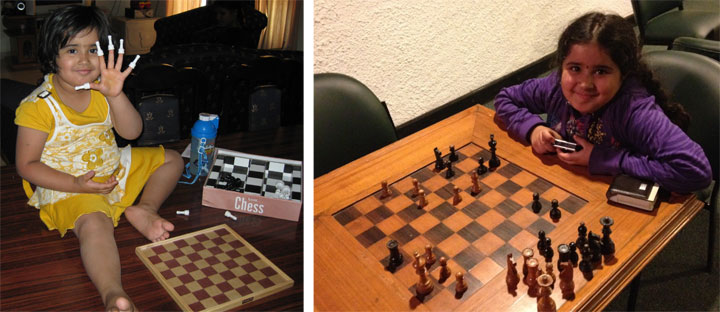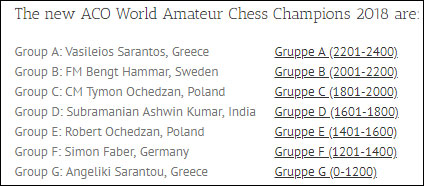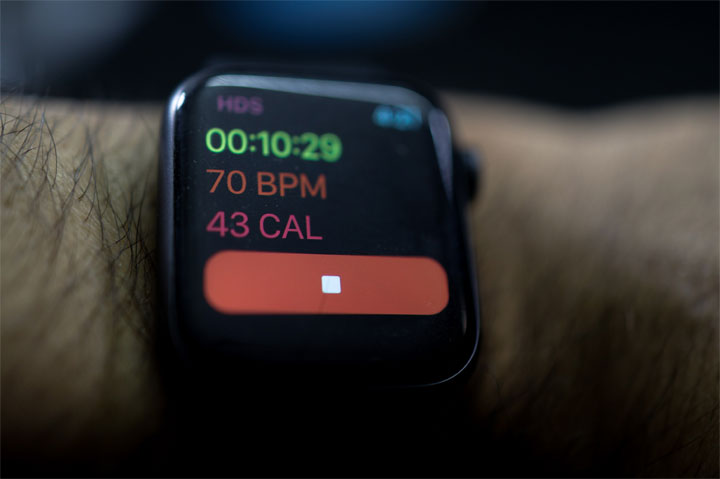


 I learnt chess in the 1980s, at the age of six or seven, but it wasn’t until large articles about the 1990 Kasparov-Karpov World Chess Championship Match, with moves in “chess language,” started appearing in a local newspaper that I really became curious about how the game was played at the highest level. My father’s friend had a book titled “Winning Chess” by Irving Chernev and Fred Reinfeld that caught my attention, so I borrowed to learn chess notation and basic tactics/strategy. I couldn’t stop reading the book and remember finishing it in less than one week, and then read it all over again!
I learnt chess in the 1980s, at the age of six or seven, but it wasn’t until large articles about the 1990 Kasparov-Karpov World Chess Championship Match, with moves in “chess language,” started appearing in a local newspaper that I really became curious about how the game was played at the highest level. My father’s friend had a book titled “Winning Chess” by Irving Chernev and Fred Reinfeld that caught my attention, so I borrowed to learn chess notation and basic tactics/strategy. I couldn’t stop reading the book and remember finishing it in less than one week, and then read it all over again!
Within a few weeks I started competing in chess tournaments at Mysore in India and kept getting better with experience. I bought and read a few more books – whatever was available at that time in Mysore. In 1992 I stood third in the Mysore District Chess Tournament with over 100 participants! I was also very lucky to have a personal computer at home (which ran DOS and used a 5¼ inch floppy disk) along with a borrowed chess program with multiple levels that quickly became my sparring partner in the early 90s! Thus began my love for chess and technology – it’s over 30 years now and I’m still passionately in love!
However, starting 1993, my priorities quickly shifted to my general education, and I had to forgo playing chess competitively. I did keep in touch with the game, following all the major chess events and technological developments surrounding the game (engines, databases, online chess, etc.)! Years passed quickly and it wasn’t until sometime around 2007 that I resumed playing online in platforms. This was great fun, but I sorely missed playing chess “competitively” in tournaments. The adrenaline rush during a game when we sense danger or spot a nice combination and the emotion experienced while winning or losing a tournament game are things I could never experience while playing casually online! Playing competitively was somehow very different!

Anjana with her first chess set, and her best chess moment – beating her father!
In 2008, I started introducing chess to my daughter and a few years later in 2012, I felt it would be great for me to take her to a chess tournament, an U7 Rapid event. I realized they had an open section, so I couldn’t resist playing myself! I felt that “rush” again, with my heart racing to such an extent that I would often forget to press my clock, with my sweaty palms, much to my opponent's delight! I finished my first tournament after nearly a 20-year break with a reasonable 3/5 in the open section with several rated players. We then started playing more weekend rapid events (including India’s strongest Rapid + Blitz Chess event organized by ChessMine in Aug 2017 where I won the best Unrated Player Award in the Rapid section), and finally, in 2017, we decided to travel to Greece to play a classical event, my first one in 25 years – the ACO World Amateur Chess Championship! I was not a rated player but with my online rating hovering in the 1600-1800 range I felt I should play in Category ‘D’. I had a great start, scoring 3/3, but with stronger opposition and increased competitive pressures, I didn’t finish the event as well, scoring only 2.5 out of the next 6 rounds, yet ending a respectable 13th out of nearly 88 participants. I vowed to do better, the following year.
After the event I analysed my games thoroughly and critically, drawing conclusions about my mistakes and reasons behind them (both from a chess and psychological standpoint). I realized that in winning positions I tended to “relax” prematurely. And when I felt I had made a mistake, it was difficult for me to recover and focus on the position, leading to more decisive mistakes. Additionally, after the first three rounds I was somehow not as decisive with my move selection and ended up often in time trouble, due to which I could neither capitalize on my advantages nor be resourceful during difficult situations.
A day before the 2018 event there was a nice talk about “Handling Tournament Pressure” by GM RB Ramesh that I attended with very valuable lessons that I decided to apply during each round.
Round 1 started disastrously for me where I simply blundered a full knight on move ten – for nothing! My opponent chuckled and I was deeply embarrassed – a key question in my mind was which door of the expansive playing hall should I walk out of after resigning the game so that very few would notice me on my way back! But then I remembered Ramesh’s golden words to just focus on the position and not the result of the game or event.
 I took a deep breath and continued playing – to my huge relief my 1720 rated opponent returned the favour after several moves, and I ended up winning the game after all! My confidence soared, but I did not have the same dream start I had in 2017, scoring 3/4, with two wins and two draws after four rounds. However, after eight rounds I was at 6.5 with two more wins and a draw – and was playing on board one on the ninth round! If I won, I would be clear first, but chose not to focus on the result before and during the game.
I took a deep breath and continued playing – to my huge relief my 1720 rated opponent returned the favour after several moves, and I ended up winning the game after all! My confidence soared, but I did not have the same dream start I had in 2017, scoring 3/4, with two wins and two draws after four rounds. However, after eight rounds I was at 6.5 with two more wins and a draw – and was playing on board one on the ninth round! If I won, I would be clear first, but chose not to focus on the result before and during the game.

I won the game – and the championship, finishing clear first as the only “unrated” player among 80 other participants from 15 countries! I also believe that my mediation practice which had grown much stronger in 2017-2018 contributed immensely to my success, as I was generally much calmer and grounded during my games!
From 2018 onwards I started seeing articles, tweets and videos about heart rate monitoring in chess, from events such as Isle of Man, Bilbao and even the Chess960 World Championship. This got me very interested in biofeedback (using sensors to measure body functions with an intent to help develop better control over these functions) technology and its usage in chess. I felt that this would be great for chess given how difficult it is to understand what the players are feeling or thinking.
In 2018 and 2019 visited the Grand Chess Tour at Kolkata, and used every opportunity to talk with players, coaches, commentators, or broadcasters to understand what they felt about biofeedback. I heard very different perspectives, ranging from reservations over such information being used for competitive advantage to tremendous excitement especially if this helps the game become more attractive to its audience, hence inviting more sponsors, which chess sorely needed!
2020 however had something very different in store for the chess world – Covid-19 lockdowns and Netflix’s “Queens Gambit” led to the popularity of online chess soaring to an all-time high! Suddenly top chess players, top comedians and top gamers were all streaming chess with thousands of simultaneous viewers! At the same time technology markets also soared, driven by increased PC demand due to remote work as well as increased demand for personal health devices such as smartwatches that could measure heart rate, calories, oxygen saturation, blood pressure and even stress.
It suddenly dawned upon me that anyone could measure their own heart rate while playing chess using a simple affordable smartwatch, share it with their audience during streams and perhaps even learn from the data! Top players could stream with their own heart rate or play training games while measuring their heart rate to learn from how they react to stress during the game! Additionally, in chess, one is often advised to “look at the whole board” to find good moves & avoid mistakes – so I wondered if we could use an eye tracker, that is often used by Twitch gamers, to track the eyes of a chess player to see what they were seeing!
I decided to continue my conversations with top players, but this time during YouTube streams or interviews! Surya Shekar Ganguly, one of India’s top grandmasters, started his YouTube channel with a series of spectacular interviews with Vishy Anand, Anish Giri, Levon Aronian & Wesley So among others! I asked these players again about their perspective on use of biofeedback in chess, and their opinions were exciting to hear! Anish Giri, for example, was very excited about eye tracking – he felt if done properly it could be very interesting! I immediately ordered a Tobii Eye Tracker! I also had an Apple Watch that enabled me to use a simple app to stream my heartrate/calories to my PC, and I could capture this data along with eye tracker output in a video while playing chess!

I measured my heart rate and calories using a simple Apple Watch with a companion Windows desktop app!
Over these two years, I had also learnt about a fascinating concept called Heart Rate Variability (HRV) and how it was emerging as an important biomarker for one’s physical/mental health and performance. Higher heart rate variability (elapsed time between two successive heartbeats) indicated a stronger ability to recover from stress, and a nice pattern (sinusoidal) meant strong Coherence (enabling optimal performance)! I also learnt that HRV training could help increase it, improving stress recovery and performance! While many new Smartwatches were measuring HRV as well to determine a stress score, continuous measurement required more specialized devices such as HeartMath’s Inner Balance. So, I invested in one of these devices as well!

I quickly learnt how to record my own online chess play with heart rate, calories, eye tracking information and even heart rate variability trends. This enabled me to address several questions such as:
How does playing competitive chess affect my heart rate, and what could I learn from this?
I had read that player had burnt hundreds of calories just sitting at the chess board for a couple of hours – how many calories would I burn?
Can eye tracking be useful during post-game analysis? Would the audience enjoy and benefit from seeing what the player is looking at?
Could HRV training improve my chess performance – especially given this was being used by athletes in other top sports such as triathlon or swimming?
I decided to address these questions, inspired by the growing use of biofeedback by top athletes in improving their performance, and also by prior experiments in chess events such as Isle of Man, by measuring my own heart rate, heart rate variability (HRV) and calories, in addition to eye tracking during a series of online chess games of various formats, to draw conclusions on how these affected my chess performance. I also spoke to several chess players, coaches, commentators and audiences to share my learningss and hear their perspectives on how such information could be useful both for audience and players.
I will be talking at the Global Chess Festival 2021 (on October 9th) and in my presentation I will introduce the concept of Biofeedback in Chess, sharing my conclusions on its usefulness (for audience and players) based on perspectives I have gathered from various players, coaches, commentators, and audiences. I will also speak about technological advancements that enable new opportunities with biofeedback in chess. I will share how such experiments can be easily done by anyone and hope to inspire an expanded use of biofeedback in chess along with additional experiments by players and institutions!
In the second part of this article I will share my findings in greater detail.

Ashwin Subramanian has been actively participating in the Global Chess Festival from 2017 onwards, visiting Budapest each year. At the opening ceremony of the 2019 festival, Ashwin and his family created and performed to an Indian classical chess themed song titled “Sabse sundar hai yeh khel” (“The Most Beautiful Game”) showcasing Indian classical music and dance. As a technology evangelist Ashwin has actively supported the technology needs of several chess players globally, including helping the Indian Chess Olympiad team rapidly address internet disconnection issues with an innovative software based solution, Speedify, in 2020. He also supports chess foundations such as the Judit Polgar Chess Foundation, Chessbase India and the ChessGurukul Charity.
The full broadcast progam is here. The Creative and Innovation talks, where Ashwin will be speaking, are from 12.30 - 14.00 on October 9, 2021.
 Main link: Judit Polgar Global Chess Festival
Main link: Judit Polgar Global Chess Festival